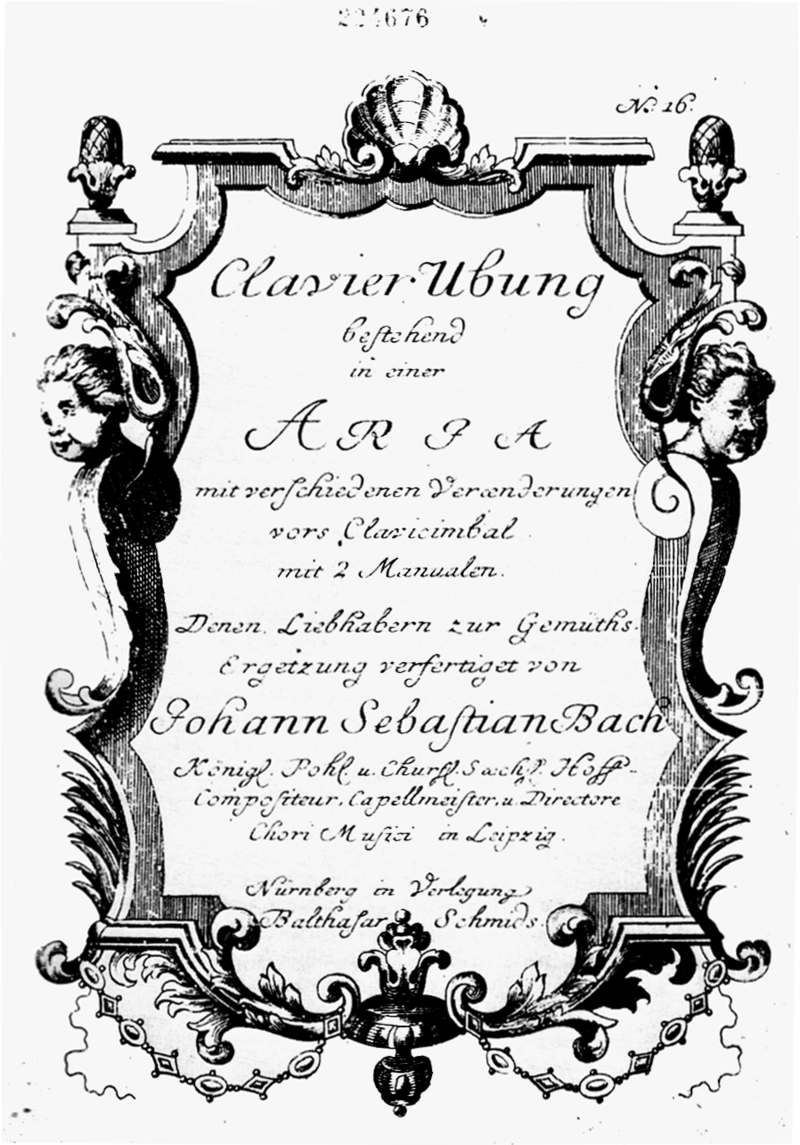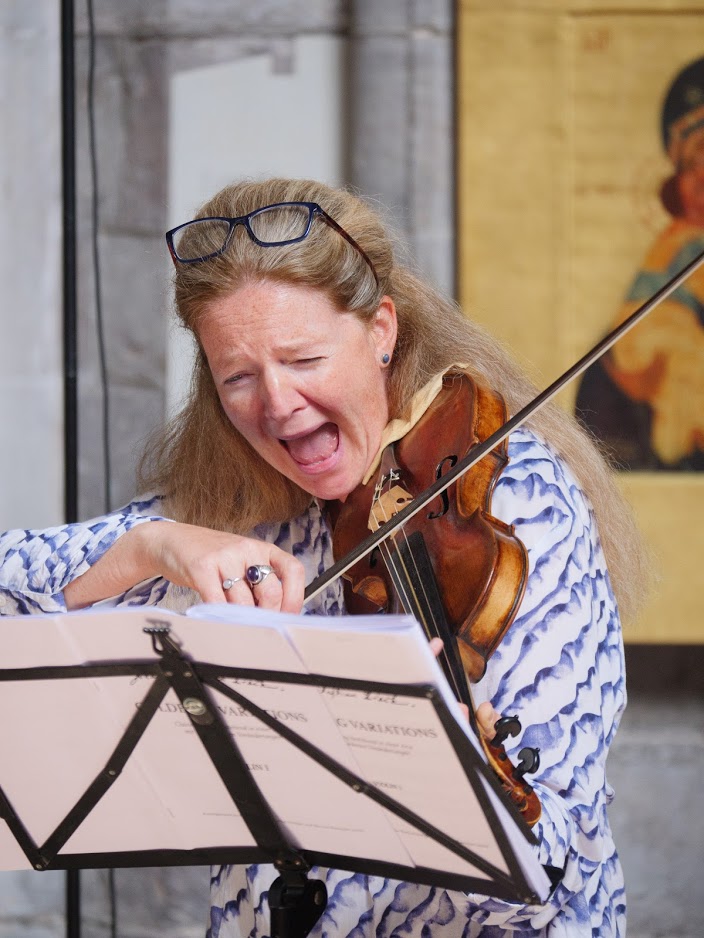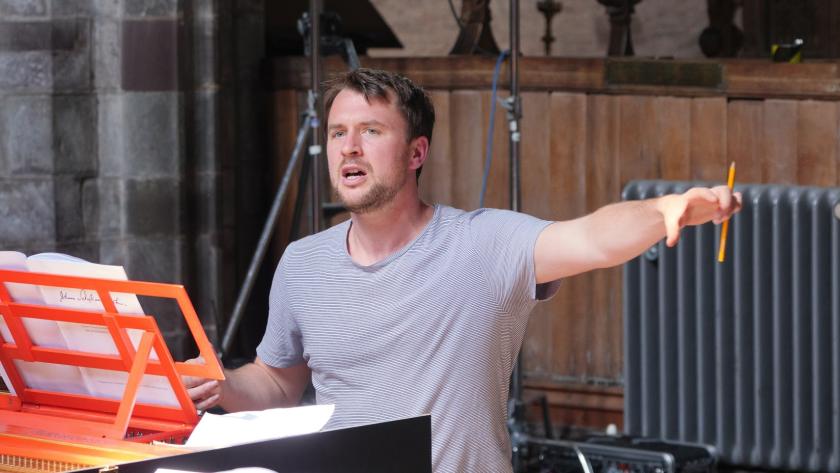As musicians took tentative steps into the unfamiliar world of PPE, socially-distanced rehearsals and audiences watching from home on a computer screen, a common water-cooler question was, “What did you do during lockdown?”. I am grateful to the Baroque violinist Rachel Podger that part of my lockdown involved rediscovering and reimagining a piece of music that I thought I knew well: the Goldberg Variations, the popular name we ascribe to Bach’s fourth Clavierübung (“Keyboard Practice”).
The work has a unique aura surrounding it, partly due to its immortalisation on screen, in books, and through certain seminal recordings. Perhaps like no other piece by Bach, the Goldbergs have knowingly or unknowingly touched a tremendous number of people. Like many, I grew up with a specific recording (that of Murray Perahia) which was played on repeat in my mother’s car. As a 9-year-old, I would sit at the piano and sightread them with youthful abandon, occasionally skipping over some of the more awkward passages. I first began truly to understand the piece, however, when using it as a compositional paradigm for my undergraduate students at Cambridge. We would try to determine how this architectural labyrinth was actually designed and how it could (or should) be realised. Since then, I have often questioned the commonly-held view of the Goldbergs: that they represent a sacrosanct work of pure, absolute and abstract art - a view propagated by pianists such as Glenn Gould and Charles Rosen. For me, this renders them little more than museum exhibitions. So, when Rachel asked nonchalantly, “Hey, so how would you feel about doing an arrangement of the Goldbergs?”, the answer was a resounding yes.
 Some existing arrangements remain piously faithful to Bach’s printed notes and, because much of the writing is particularly idiomatic to the keyboard, those arrangements inevitably result in orchestral gimmickry. This, to me, feels anachronistic. To listeners it no longer sounds like Bach, and to players it no longer feels like Bach. The notion that the printed ink is in some way sacred is very much a byproduct of 19th-century fetishism for the past. We should remember that composers of Bach’s era were a lot more laid back, living life in the present; they were some of greatest exponents of borrowing, reworking and rewriting their own works and the works of their colleagues. This present arrangement attempts to be idiomatic to the historical instruments and idiomatic to the individual styles and genres referenced in the work, whilst remaining true to the essence of the piece. At times it has required a liberal reading of the original text, or to put it another way, this arrangement prioritises an authenticity to the instruments performing the music over the notes on the page.
Some existing arrangements remain piously faithful to Bach’s printed notes and, because much of the writing is particularly idiomatic to the keyboard, those arrangements inevitably result in orchestral gimmickry. This, to me, feels anachronistic. To listeners it no longer sounds like Bach, and to players it no longer feels like Bach. The notion that the printed ink is in some way sacred is very much a byproduct of 19th-century fetishism for the past. We should remember that composers of Bach’s era were a lot more laid back, living life in the present; they were some of greatest exponents of borrowing, reworking and rewriting their own works and the works of their colleagues. This present arrangement attempts to be idiomatic to the historical instruments and idiomatic to the individual styles and genres referenced in the work, whilst remaining true to the essence of the piece. At times it has required a liberal reading of the original text, or to put it another way, this arrangement prioritises an authenticity to the instruments performing the music over the notes on the page.
Johann Joachim Quantz wrote in his seminal 1752 treatise On Playing the Flute, “The success of a piece of music depends almost as much on the players as the composer”. Vital to the concept of this arrangement and its performance was that it must be realised by historically-aware non-keyboardists using period instruments - specifically, performers who came without any extra preconceptions, allowing fresh and unfettered insight into this well-known work. I wanted the players to be active protagonists in the musical discourse, to stamp it with their instruments’ qualities and shape it with their own personalities, because while the Goldbergs could only ever have been composed by Bach, they are stamped with, and shaped by, many different influences in Bach’s sphere. This sphere teems with a varied roster of protagonists. Let me set the scene.
In 1737, Johann Adolf Scheibe, a German composer and theorist, published a now-notorious article which criticised Bach’s music as being excessively complex and of unnatural artifice - incidentally, it is precisely these qualities that have appealed to generations of scientists and performers such as Gould. Scheibe also described Bach as the greatest contemporary keyboardist, so the criticism was not as acrimonious as it might immediately appear. It is, however, telling: there was a new musical aesthetic in Europe, and it was not Bach’s. The emphasis was on expression and impact, and one of the defining features was a highly affected melodic style. Developed in the cultural melting pot of the opera house, a new pre-classical, Galant style had emerged. A vibrant Neapolitan style had been imported to musical centres such as Dresden, by composers such as Bach’s friend, Johann Adolph Hasse. Other notable exponents of this style included Bach’s own son, Carl Philipp Emanuel, who by the early 1740s was established in the rich musical tapestry of Berlin, alongside the aforementioned Quantz.
 I was keen that my arrangement would in some way reflect this vibrant sphere of influence, just as it is reflected by Bach throughout the Goldbergs. One doesn’t need to look further than the opening Aria to witness Bach’s flattering mimicry of the new Galant style. Directly in juxtaposition, however, we find arcane canonic writing of the utmost intricacy. This arrangement uses an orchestral palate to paint the vivid scene between these two contrasting influences. When I considered how best to use the instruments, I was reminded of a quote from the late, great, historical wind player and musicologist Bruce Haynes, who believed that, “Bach valued the distinctive qualities of each instrument […and] wrote with friendship and affection for all of them.” For me, it was such a joy to impart this music, with friendship and affection, to my dear colleagues of Brecon Baroque (Rachel Podger pictured above).
I was keen that my arrangement would in some way reflect this vibrant sphere of influence, just as it is reflected by Bach throughout the Goldbergs. One doesn’t need to look further than the opening Aria to witness Bach’s flattering mimicry of the new Galant style. Directly in juxtaposition, however, we find arcane canonic writing of the utmost intricacy. This arrangement uses an orchestral palate to paint the vivid scene between these two contrasting influences. When I considered how best to use the instruments, I was reminded of a quote from the late, great, historical wind player and musicologist Bruce Haynes, who believed that, “Bach valued the distinctive qualities of each instrument […and] wrote with friendship and affection for all of them.” For me, it was such a joy to impart this music, with friendship and affection, to my dear colleagues of Brecon Baroque (Rachel Podger pictured above).
Bach the friend, Bach the affectionate... John Eliot Gardiner rather chooses the word cantankerous. This may well have been the case during the 1720s, when he was publicly at war with his employers in Leipzig. However, by 1740 - the year he is believed to have begun work on the Goldbergs - he had endured a decade of disillusionment with his employment. Furthermore, he had suffered the rejection of two unsuccessful job applications and had sustained Scheibe’s public attack. He had also mourned the premature death of his son, Gottfried Bernhard. The composition of the Goldberg Variations has to be seen in this light, and perhaps also a review of the “cantankerous” label would be worthwhile.
Musicologist Alan Street makes a very convincing argument that the Goldbergs were a rhetorico-musical rebuttal to Scheibe’s criticism. A broader interpretation might also suggest that Bach was simultaneously acknowledging and assimilating the new popular style, whilst remaining true to his own dearly-held and seemingly antiquated musical beliefs. We therefore see the Bach of 1740 at a crossroads, both artistically and personally. He seems to have accepted a Janus-like view of where he was standing in musical history: one foot entrenched in the past, and the other stepping out towards the future.















Add comment